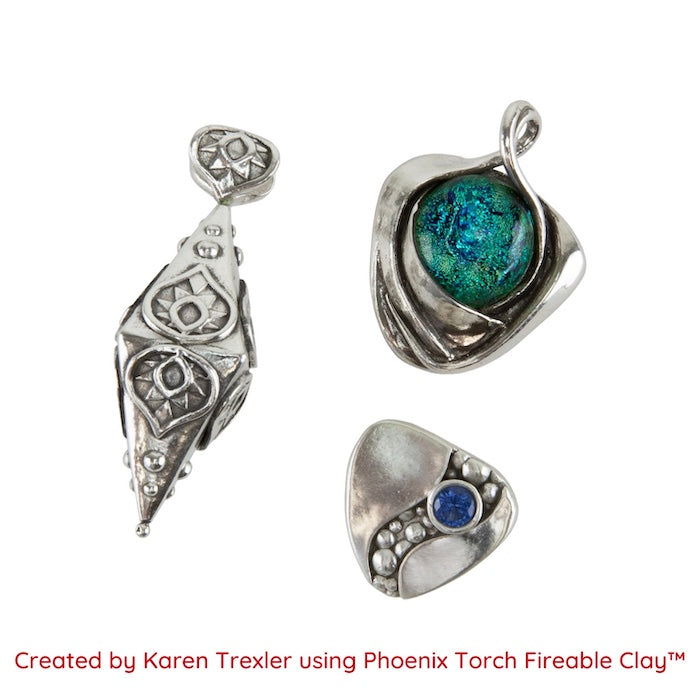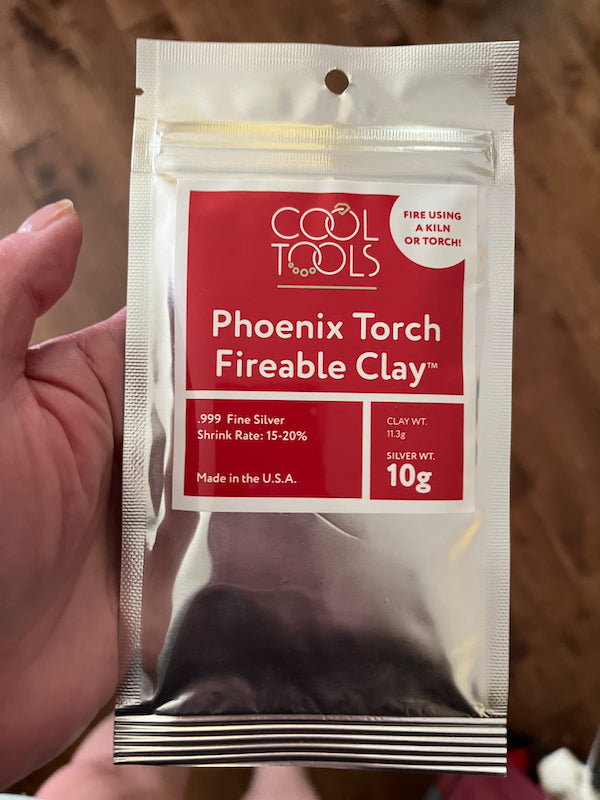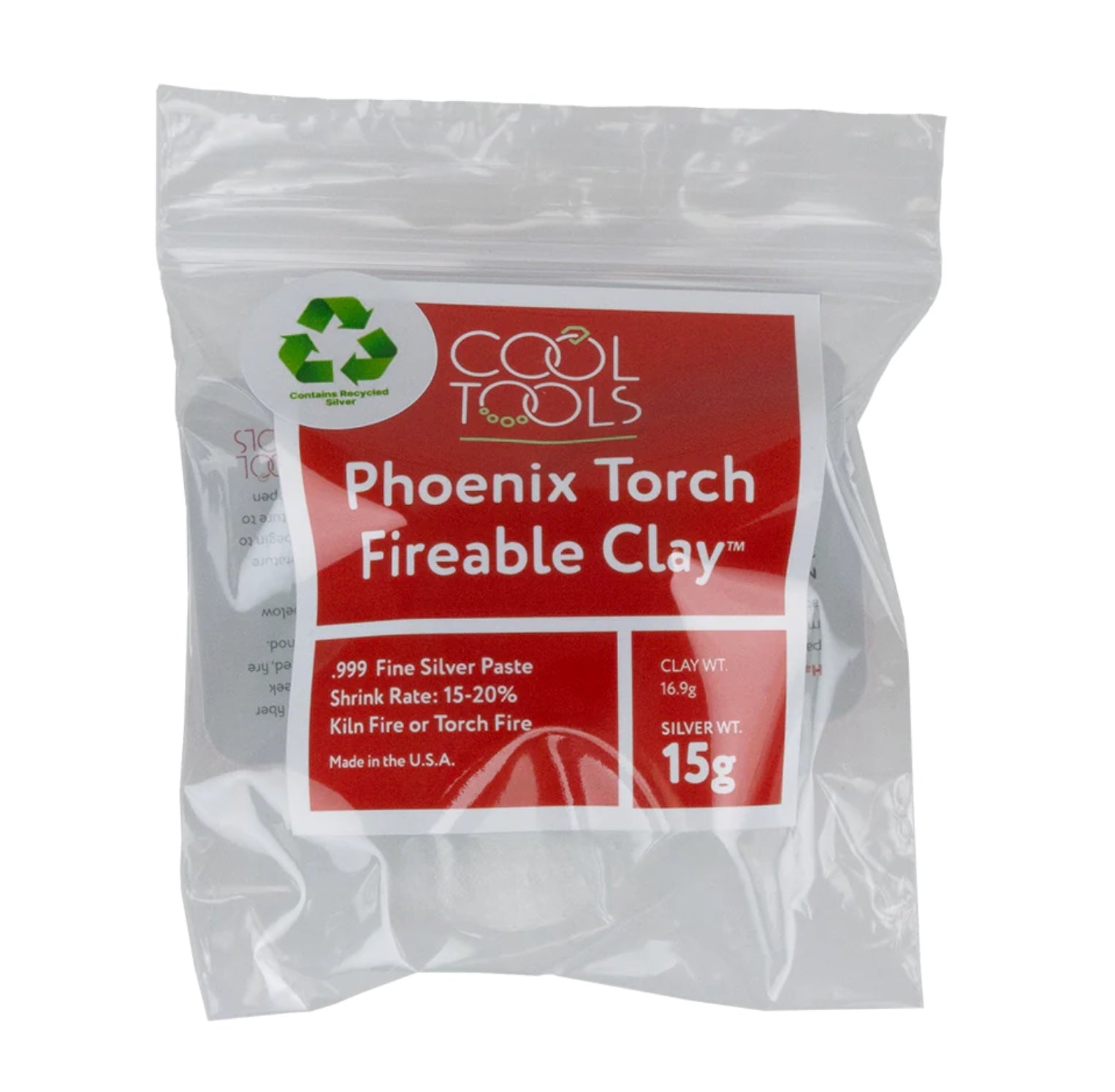









Phoenix Torch & Kiln fire clay, Fine Silver lump clay, paste or syringe
$47.24 - $241.73
Phoenix Torch Fireable Clay is a great, all purpose metal clay with excellent working properties and can be fired with a kiln or torch. Because it can fire at low temperatures, it is the perfect clay for co-firing with glass. Its density provides strength in the greenware state, and after firing, it's ideal for soldering, enameling, bending and polishes to a beautiful high shine. 60.2 gr clay (50 gram fired) or 30gr clay (25 gram fired)
30 gr clay (25 gram fired) = $2.86 CAD/gram or $2.07 USD/gram
60.2 gr clay (50 gram fired) = $2.77 CAD/gram or $2 USD/gram
Made in the USA
Click here for the Phoenix Torch Fireable Clay Overview & Firing Guide
Torch Fire: Peachy glow for 4-5 minutes
Kiln Fire: 1100°F / 593°C for 45 minutes
1200°F / 649°C for 30 minutes
1290°F / 699°C for 15 minutes
1380°F / 749°C for 10 minutes
1475°F / 802°C for 5 minutes
1650°F / 899°C for 5 minutes minimum, 2 hours for optimal sintering/maximum strength
Shrinkage: 15% - 20%
Conditioning
Clay may seem firm or stiff directly out of the package. Condition the clay prior to use by repeatedly rolling and folding the clay to achieve desired consistency. Kneading may also be used as a technique to condition the clay, but a lotion such as ClayMate should be applied to hands prior to doing so to assure the clay will not be dried out in the conditioning process. While conditioning is not necessary for all uses, this clay may exhibit a “memory” if not conditioned. If clay will be draped on an armature to take a form, or if clay is not holding shapes applied as desired, try conditioning the clay and adding additional moisture (distilled water). This will relax the clay and lessen its “memory”.
Wet Clay
Phoenix clay is perfect for beginners– elastic and highly impressionable, this clay sculpts beautifully with additive and reductive processes while in the lump form. With a dense and elastic malleability, this clay is strong while wet and holds forms and shapes very well. Phoenix clay rolls, impresses and molds to a high level of detail without sticking to hands and with minimal sticking to tools. For best long term storage and to maintain hydration and workability, store opened and unused Phoenix in a clay hydrator charged with distilled water.
Greenware Working Qualities
Very sturdy when dry, this clay can be shaped in the greenware stage with files or sanding sticks. This clay is an ideal candidate for refinement while it is in the greenware stage. 3M sanding sponges can be used to eliminate surface blemishes. Depending on the depth of the blemishes, it is recommended to start with superfine sanding sponge and work progressively to finer grits (ultrafine, and finally microfine). As always, support pieces while sanding by holding work along edges that are being sanded and support behind sanded faces, to minimize the chance of breaking a piece. This clay creates a very fine dust when sanded, and wearing a mask while sanding is recommended.
Wet refinement may also be used for this clay with optimal results. Use a damp foam tool to soften the area in need of refinement, and gently rub or burnish the affected area which will reallocate material from higher areas to fill into any low areas or scratches.
This clay may also be prepared for a mirror finish when fired and polished by being burnished in the greenware stage. The compression of the particles while in the greenware stage works much like compression or burnishing would when sintered, closing the surface of metallic particles and increasing reflection and thus shine.
When drilling this clay in the greenware stage, start off with a smaller bit to drill a pilot hole, and work your way up in bits to your desired size. The density of this clay makes it difficult to drill large holes, and by starting small and working your way up you reduce the chance of cracking your piece. Also noted in testing, drying with heat increases the stiffness of this clay. If carving or inscribing will be done on dried clay, it is recommended the clay is left to air dry, as drying with heat will result in a very hard surface.
Dry Construction
This clay is moderately flexible when in the greenware stage. While not as flexible as EZ960® or FS999™, measures can be taken to increase its flexible qualities if more flexibility is required. A drop or two of glycerin can be added to this clay in its lump form to increase the flexibility the clay will have once dry. It was noted in testing; however, that the addition of glycerin does lead thin, longer pieces (for instance, clay rolled out to be a thin sheet) warping some with drying. The warping is easily manipulated out of the piece once dry.
Embedding Objects
Nano gems, cubic zirconia, lab created gemstones, bezel cups and other findings or embeddables can be co-fired with Phoenix. Please refer to our Gemstone Firing Guide for a comprehensive list of gemstones that are compatible with the firing times and temperatures of Phoenix.
Firing
Ensure clay is bone dry prior to firing it. Failure to do so will result in bubbles in your sintered work. Phoenix’s binder retains water, which results in this clay having a long working time; however, it also means that this clay is slower to dry than other precious metal clays. Ensure pieces are completely dry prior to firing by using a heat source such as a mug/ candle warmer or a dehydrator. This clay, depending on what is potentially embedded in it, if it is being co-fired with glass, or how much time is available for the clay to be sintered, has several firing schedules all of which will produce a successful sinter.
Kiln Fire:
- 1100°F / 593°C for 45 minutes
- 1200°F / 649°C for 30 minutes
- 1290°F / 699°C for 15 minutes
- 1380°F / 749°C for 10 minutes
- 1475°F / 802°C for 5 minutes
- 1650°F / 899°C for 5 minutes minimum, 2 hours for optimal sintering/maximum strength
Torch Fire: Peachy Glow for 4-5 min
This Clay may also be fired with a butane torch. Using the color the piece will glow when heated as an indicator for target temperature, heat the piece until it is glowing a peach color. Note: when heat is initially applied, a small flame and fume is to be expected- that is the binders burning off from the fine silver. When the piece is glowing a peachy color, start the timing of the firing, and maintain the peachy glow for four to five minutes. Allow the piece too cool, or quench it. Note: do not quench any pieces that have stones fired in place, as the quenching will cause thermal shock in the stones and cause them to break. Safety note: Always use safe firing practices when torch firing clay. Work in a well ventilated environment that is clear of flammable materials. Wear safety glasses, pull back any long hair or loose sleeves, and wear closed toe shoes.









